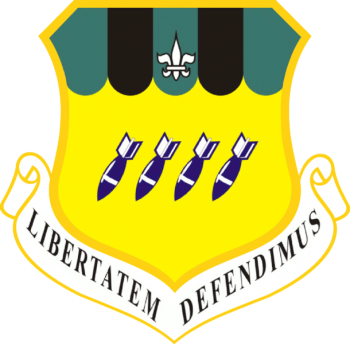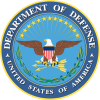2nd Bombardment Wing, US Air Force: Difference between revisions
No edit summary |
No edit summary |
||
| (19 intermediate revisions by 2 users not shown) | |||
| Line 1: | Line 1: | ||
History: Established as 2 Bombardment Wing, Very Heavy on 15 October 1947. Organized on 5 November 1947. Redesignated as:2 Bombardment Wing, Medium on 12 July 1948; 2 Bombardment Wing, Heavy on 1 April 1963; 2 Wing on 1 September 1991; 2 Bomb Wing on 1 October 1993. Wing Headquarters not operational, 5 November 1947–31 December 1948. The 2 Bombardment Group, except for a short period it spent in England in 1948, was attached to the 43 Bombardment Group, 17 November 1947–31 December 1948. Entire wing moved from Arizona to Georgia on 1 January 1949 and manned from resources of other organizations. Converted from B-29 to B-50 bombers in 1949–1950 and trained in global bombardment operations from January 1949. Added air refueling mission in December 1950. Deployed at RAF Mildenhall, England, May–August 1951, RAF Upper Heyford, England, September–December 1952, and Sidi Slimane AB, French Morocco, August–September 1954 and July–August 1956. Converted to B-47 jet bombers in 1954. Service-tested a “super wing” concept with 70 B-47s, July 1959–April 1961. Moved to Barksdale AFB, LA, on 1 April 1963, replacing 4238 Strategic Wing and absorbing that wing’s B-52 and KC-135 resources. Supported Second Air Force’s post-attack command and control system, April 1963–March 1970. Conducted bombardment training and air refueling operations from April 1963 except for periods when all aircraft and crews were on loan to Strategic Air Command (SAC) organizations involved in combat operations in Southeast Asia. Began supporting SAC operations in Southeast Asia with aircraft and personnel in 1965, and increasingly supported these operations in 1966 and 1967. On 15 April 1968, gained a second B-52 and a second KC-135 squadron, again becoming a SAC “super” wing. From late May 1972 until 26 October 1973, loaned all wing B-52 resources to SAC organizations in the Far East and Southeast Asia; from May 1972 to early Nov 1972, loaned all but four of the wing’s KC-135s and a few aircrews to other SAC units. After the return of combat resources, the wing continued supporting SAC operations in Southeast Asia into 1975, on a reduced scale. Gained KC-10 tankers in November 1981 to augment refueling operations for the USAF, AFRES, and ANG. Provided air refueling for rescue efforts in Grenada, October–November 1983, the attack on Libya, April 1986, and the invasion of Panama, December 1989–January 1990. Presented the Omaha Trophy for “the Outstanding Wing in the Strategic Air Command” for 1988 and 1992 and, after inactivation of SAC, received the trophy from the U.S. Strategic Command as the “best flying unit in STRATCOM” for 1994 and 1996. | |||
Deployed B-52, KC-135, and KC-10 aircraft, aircrews, and support personnel to several locations in support of operations in Southwest Asia, 7 August 1990–17 April 1991. On 16 January 1991, launched seven B-52s from Barksdale AFB against enemy targets in Iraq, and launched conventional Air Launched Cruise Missiles (ALCM) for the first time in combat. Gave up the 2 and 32 Air Refueling Squadrons and all KC-10s to Air Mobility Command on 1 June 1992. After the Strategic Arms Reduction Treaty (START) with Russia went into force in December 1994, Barksdale AFB was the first base selected for compliance inspection in Jul 1995 and underwent such inspections yearly thereafter. Continued to train for long range conventional strike capability as well as maintaining nuclear operational readiness. In response to Saddam Hussein’s attacks against the Kurdish minority in northern Iraq, wing crews (96 BS) deployed and launched attacks against military targets in Iraq in September 1996 (Operation Desert Strike). 96 BS crews received the Mackay trophy for this 33-hour long mission as the most meritorious flight of 1996. Continued to deploy aircraft and personnel to SWA to support the Allied watch on the southern and northern “no-fly” zones in Iraq. Flew combat missions against targets in Iraq, 17-18 December 1998, in response to Iraq’s refusal to allow UN weapons inspectors to continue work (Operation Desert Fox). Flew combat missions against targets in Yugoslavia, 24 March-9 June 1999, in support of NATO Operation Allied Force. In October 1999 began deploying personnel in support of aerospace expeditionary forces (AEF) worldwide and taking its turn as lead wing for such AEF taskings. After the terrorist attacks against the U.S. on 11 September 2001, the wing has been committed to almost non-stop action in the war against global terrorism. On 19 September 2001, wing elements, including the 20 BS, deployed to Diego Garcia and on 7 October flew early attacks on targets in Afghanistan in Operation Enduring Freedom to rid that country of terrorist bases and its extremist Taliban rulers; later flew airborne alert missions and, in Operation Anaconda, flew bombing missions against targets in eastern Afghanistan, 1-18 March 2002. In the invasion of Iraq in March 2003, flew missions on 21 March in “shock and awe” strikes against command and control targets (Operation Iraqi Freedom). Provided bomber combat power and expeditionary combat support to warfighters, 2004-. | |||
| | {| class="wikitable" | ||
|- style="vertical-align:top;" | |||
|[[File:bw2.png|center|350px|Coat of arms (crest) of {{PAGENAME}}]] | |||
| | |||
<center>''' {{uc:{{PAGENAME}}}} '''</center><br> | |||
'''Country''':United States[[File:Usa.jpg|60 px|right]]<br><br><br> | |||
|} | |||
{| class="wikitable" | |||
|+Official blazon | |||
|- | |||
|'''English''' | |||
|blazon wanted. | |||
|} | |||
===Origin/meaning=== | |||
Approved for 2nd Group on 19 January 1924 and 2nd Wing on 10 August 1951; latest rendering, 16 October 2018. | |||
[[Literature]]:Image from Wikimedia Commons. Information from https://www.afhra.af.mil/ | |||
{{us}} | |||
{{media}} | |||
[[Category:Military heraldry of the United States]] | |||
[[Category:Air Force heraldry]] | |||
[[Category:Granted 1924]] | |||
Latest revision as of 10:14, 21 October 2024
History: Established as 2 Bombardment Wing, Very Heavy on 15 October 1947. Organized on 5 November 1947. Redesignated as:2 Bombardment Wing, Medium on 12 July 1948; 2 Bombardment Wing, Heavy on 1 April 1963; 2 Wing on 1 September 1991; 2 Bomb Wing on 1 October 1993. Wing Headquarters not operational, 5 November 1947–31 December 1948. The 2 Bombardment Group, except for a short period it spent in England in 1948, was attached to the 43 Bombardment Group, 17 November 1947–31 December 1948. Entire wing moved from Arizona to Georgia on 1 January 1949 and manned from resources of other organizations. Converted from B-29 to B-50 bombers in 1949–1950 and trained in global bombardment operations from January 1949. Added air refueling mission in December 1950. Deployed at RAF Mildenhall, England, May–August 1951, RAF Upper Heyford, England, September–December 1952, and Sidi Slimane AB, French Morocco, August–September 1954 and July–August 1956. Converted to B-47 jet bombers in 1954. Service-tested a “super wing” concept with 70 B-47s, July 1959–April 1961. Moved to Barksdale AFB, LA, on 1 April 1963, replacing 4238 Strategic Wing and absorbing that wing’s B-52 and KC-135 resources. Supported Second Air Force’s post-attack command and control system, April 1963–March 1970. Conducted bombardment training and air refueling operations from April 1963 except for periods when all aircraft and crews were on loan to Strategic Air Command (SAC) organizations involved in combat operations in Southeast Asia. Began supporting SAC operations in Southeast Asia with aircraft and personnel in 1965, and increasingly supported these operations in 1966 and 1967. On 15 April 1968, gained a second B-52 and a second KC-135 squadron, again becoming a SAC “super” wing. From late May 1972 until 26 October 1973, loaned all wing B-52 resources to SAC organizations in the Far East and Southeast Asia; from May 1972 to early Nov 1972, loaned all but four of the wing’s KC-135s and a few aircrews to other SAC units. After the return of combat resources, the wing continued supporting SAC operations in Southeast Asia into 1975, on a reduced scale. Gained KC-10 tankers in November 1981 to augment refueling operations for the USAF, AFRES, and ANG. Provided air refueling for rescue efforts in Grenada, October–November 1983, the attack on Libya, April 1986, and the invasion of Panama, December 1989–January 1990. Presented the Omaha Trophy for “the Outstanding Wing in the Strategic Air Command” for 1988 and 1992 and, after inactivation of SAC, received the trophy from the U.S. Strategic Command as the “best flying unit in STRATCOM” for 1994 and 1996.
Deployed B-52, KC-135, and KC-10 aircraft, aircrews, and support personnel to several locations in support of operations in Southwest Asia, 7 August 1990–17 April 1991. On 16 January 1991, launched seven B-52s from Barksdale AFB against enemy targets in Iraq, and launched conventional Air Launched Cruise Missiles (ALCM) for the first time in combat. Gave up the 2 and 32 Air Refueling Squadrons and all KC-10s to Air Mobility Command on 1 June 1992. After the Strategic Arms Reduction Treaty (START) with Russia went into force in December 1994, Barksdale AFB was the first base selected for compliance inspection in Jul 1995 and underwent such inspections yearly thereafter. Continued to train for long range conventional strike capability as well as maintaining nuclear operational readiness. In response to Saddam Hussein’s attacks against the Kurdish minority in northern Iraq, wing crews (96 BS) deployed and launched attacks against military targets in Iraq in September 1996 (Operation Desert Strike). 96 BS crews received the Mackay trophy for this 33-hour long mission as the most meritorious flight of 1996. Continued to deploy aircraft and personnel to SWA to support the Allied watch on the southern and northern “no-fly” zones in Iraq. Flew combat missions against targets in Iraq, 17-18 December 1998, in response to Iraq’s refusal to allow UN weapons inspectors to continue work (Operation Desert Fox). Flew combat missions against targets in Yugoslavia, 24 March-9 June 1999, in support of NATO Operation Allied Force. In October 1999 began deploying personnel in support of aerospace expeditionary forces (AEF) worldwide and taking its turn as lead wing for such AEF taskings. After the terrorist attacks against the U.S. on 11 September 2001, the wing has been committed to almost non-stop action in the war against global terrorism. On 19 September 2001, wing elements, including the 20 BS, deployed to Diego Garcia and on 7 October flew early attacks on targets in Afghanistan in Operation Enduring Freedom to rid that country of terrorist bases and its extremist Taliban rulers; later flew airborne alert missions and, in Operation Anaconda, flew bombing missions against targets in eastern Afghanistan, 1-18 March 2002. In the invasion of Iraq in March 2003, flew missions on 21 March in “shock and awe” strikes against command and control targets (Operation Iraqi Freedom). Provided bomber combat power and expeditionary combat support to warfighters, 2004-.
|
Country:United States |
| English | blazon wanted. |
Origin/meaning
Approved for 2nd Group on 19 January 1924 and 2nd Wing on 10 August 1951; latest rendering, 16 October 2018.
Literature:Image from Wikimedia Commons. Information from https://www.afhra.af.mil/
US heraldry portal
This page is part of the US heraldry portal |
Heraldry of the World |
|
US heraldry:
|
Ecclesiastical Heraldry of the USA:
Military Heraldry: |
Contact and Support
Partners:
Your logo here ?
Contact us
© since 1995, Heraldry of the World, Ralf Hartemink 
Index of the site
















